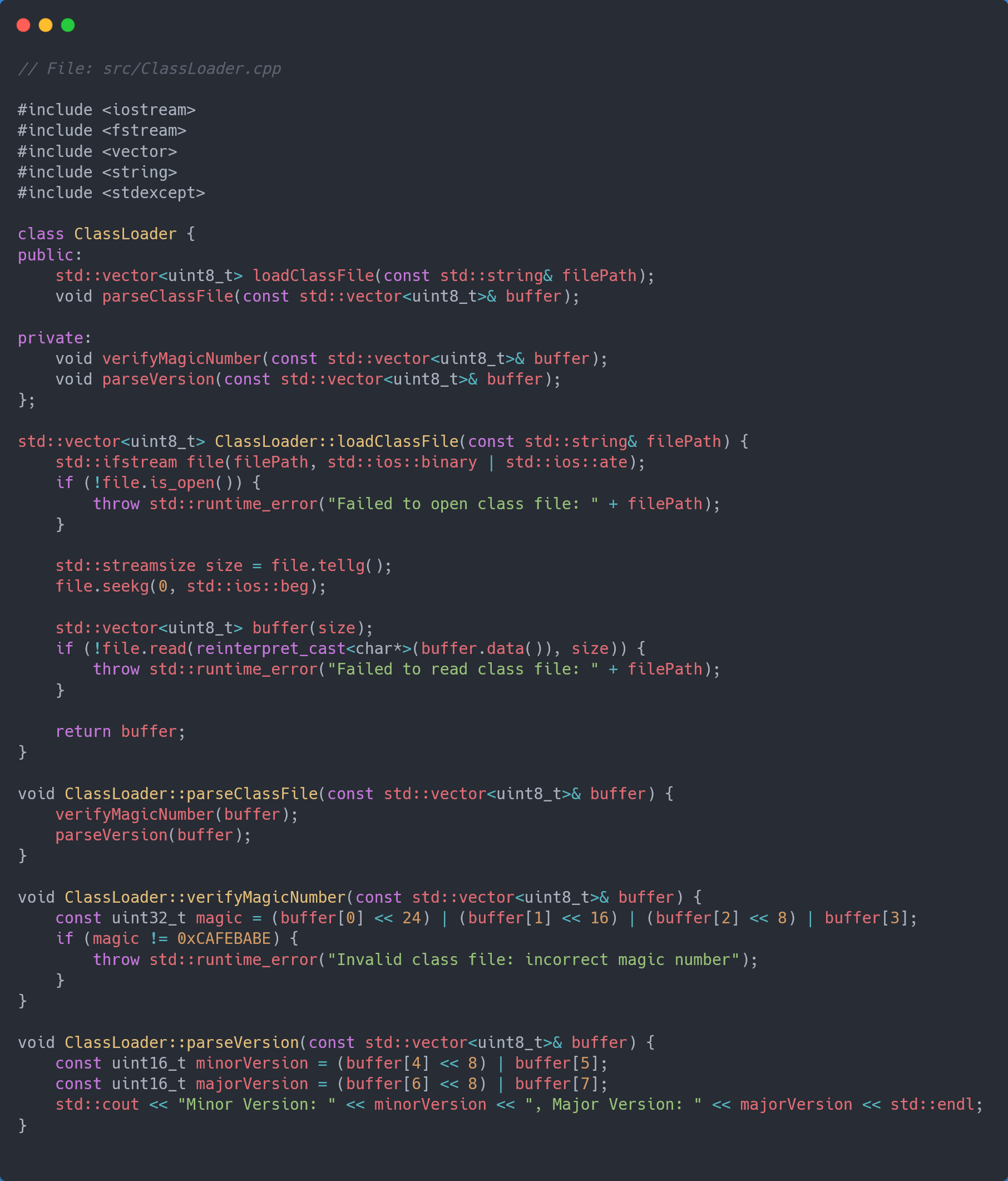

The first implementation of CVM (in C) : CMV/archive
The WIP re-implementation of CVM a.k.a CVM++ (in C++) : CVM/dev
CVM++About a year ago, I decided to write a jvm in C, and I did. It just wasn’t quite what I wanted and it lacked many functions. Actually, I wrote a java debugger on a binary level rather than a jvm. A year later, I decided to look at this project again and give it the functionality it deserves. This time, I decided to step out of my comfort zone and do it in C++ instead of C (Also, I’m too old to deal with string manipulation in C anymore).
I believe this series will be quite long and will be useful for both Java and C++. Welcome to the first part.
Since I didn’t want to make the same mistakes as last time, I wanted to start by writing the functional requirements of the jvm that I wanted to create. The software I will make throughout this series will have the following functional requirements.
Of course, a JVM that can be used for real production should have much more than these features. But my goal in this series is to make a working jvm, it does not need to be used in the real world.
.class file ?A .class file is a binary file format used by the Java programming language to store compiled Java bytecode. When you compile a Java source file (.java), the Java compiler (javac) generates a .class file for each class defined in the source code.
The structure of .class
A .class file follows a specific structure defined by the Java Virtual Machine Specification. Here’s a brief overview of its structure:
The purpose of .class:
.class files serve as the intermediary between Java source code and the Java Virtual Machine (JVM). They contain the compiled bytecode, which is platform-independent and can be executed by any JVM regardless of the underlying hardware and operating system. When you run a Java application, the JVM loads the appropriate .class files, interprets the bytecode, and executes the program instructions.

My modest goal is this, I will write a very small Java program and my own JVM will run this program. For this, I created a structure like this:
├── CMakeLists.txt
├── CONTRIBUTING.md
├── Dockerfile
├── LICENSE
├── Makefile
├── PULL_REQUEST_TEMPLATE.md
├── README.md
├── cmake
│ ├── CVMConfig.cmake.in
│ ├── CompilerWarnings.cmake
│ ├── Conan.cmake
│ ├── Doxygen.cmake
│ ├── SourcesAndHeaders.cmake
│ ├── StandardSettings.cmake
│ ├── StaticAnalyzers.cmake
│ ├── Utils.cmake
│ ├── Vcpkg.cmake
│ └── version.hpp.in
├── codecov.yaml
├── docs
│ └── banner.jpg
├── include
│ └── cvm
│ ├── fmt_commons.hpp
│ └── tmp.hpp
├── sample
│ ├── Add.class
│ └── Add.java
├── src
│ ├── main.cpp
│ └── tmp.cpp
└── test
├── CMakeLists.txt
└── src
└── tmp_test.cpp
I thought it was a modern and very versatile project structure, so I started writing the Java code that I would run next.
public class Add {
public static int add(int a, int b) {
return a + b;
}
}
As you can see, it is a very simple program, then I compiled this program with javac and created the .class file.
The hexdump of the .class file:
00000000: cafe babe 0000 0042 000f 0a00 0200 0307 .......B........
00000010: 0004 0c00 0500 0601 0010 6a61 7661 2f6c ..........java/l
00000020: 616e 672f 4f62 6a65 6374 0100 063c 696e ang/Object...<in
00000030: 6974 3e01 0003 2829 5607 0008 0100 0341 it>...()V......A
00000040: 6464 0100 0443 6f64 6501 000f 4c69 6e65 dd...Code...Line
00000050: 4e75 6d62 6572 5461 626c 6501 0003 6164 NumberTable...ad
00000060: 6401 0005 2849 4929 4901 000a 536f 7572 d...(II)I...Sour
00000070: 6365 4669 6c65 0100 0841 6464 2e6a 6176 ceFile...Add.jav
00000080: 6100 2100 0700 0200 0000 0000 0200 0100 a.!.............
00000090: 0500 0600 0100 0900 0000 1d00 0100 0100 ................
000000a0: 0000 052a b700 01b1 0000 0001 000a 0000 ...*............
000000b0: 0006 0001 0000 0001 0009 000b 000c 0001 ................
000000c0: 0009 0000 001c 0002 0002 0000 0004 1a1b ................
000000d0: 60ac 0000 0001 000a 0000 0006 0001 0000 `...............
000000e0: 0003 0001 000d 0000 0002 000e ............
We will be doing a detailed review of this hexdump in the series. But I would like to draw attention to the phrase cafe babe at the beginning. This is a magic number used to verify that what the JVM is reading is a .class file. Maybe I’ll tell you his story sometime. Anyway, after this point, I had a .class file, now all I have to do is load this class file and then parse it. At this point, I’m taking advantage of Oracle’s JVM specification.
So here is my base class loader class:

I started the project with this simple loader. Basically, its function is to load the class file compiled with javac into memory and validate it.
std::vector<uint8_t> loadClassFile(const std::string& filePath): Loads the .class file from the specified file path into memory.void parseClassFile(const std::vector<uint8_t>& buffer): Parses the contents of the .class file buffer.Thanks to this class, I was able to import .class files and start processing them. We will examine the structure of these .class files in the next part of the series, until then, goodbye.

jvm java cpp compiler © Levent Kaya. All Rights Reserved.